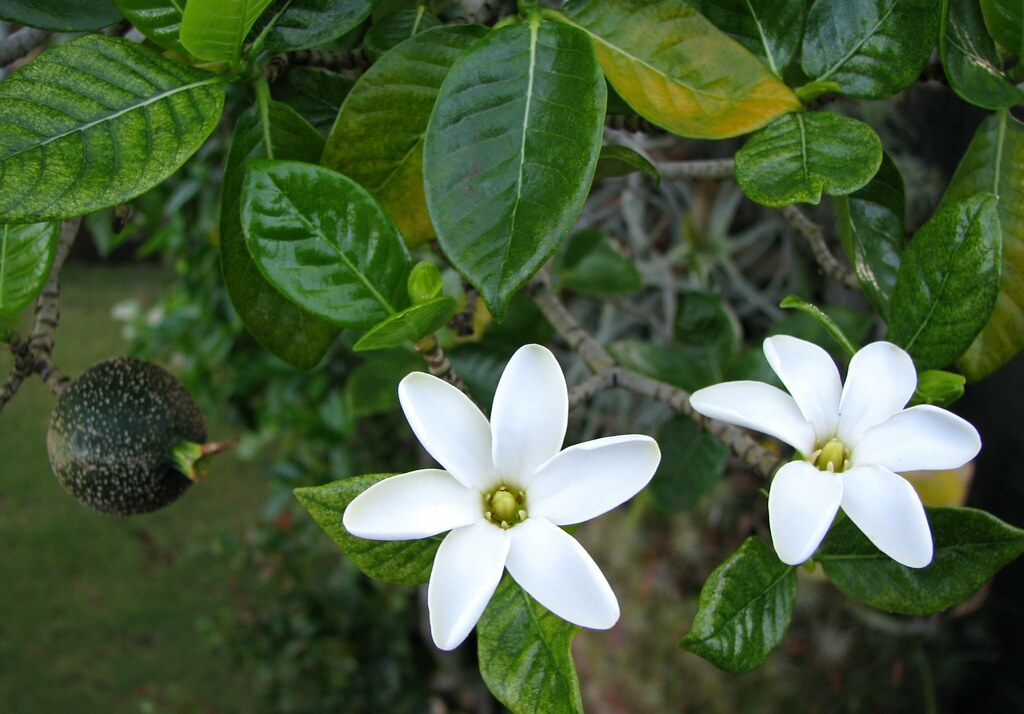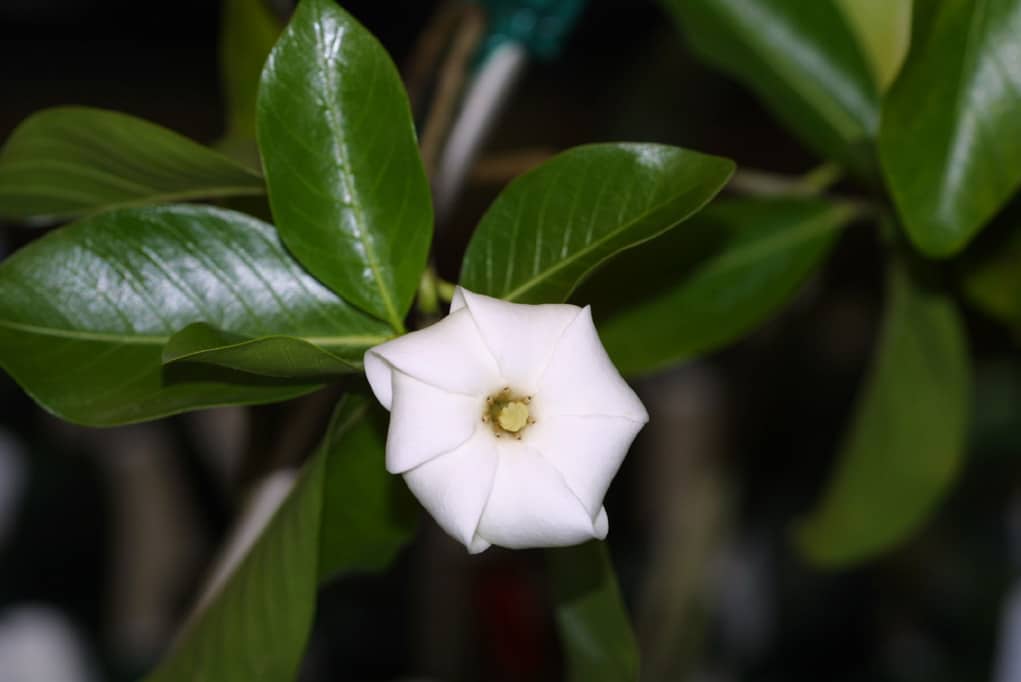Gardenia brighamii, commonly known as Nanu, is a rare native Hawaiian tree prized for its fragrant white blooms. Gardenia brighamii thrives in the dry tropical forests of islands like Oahu and Lāna‘i. Historically common, today only a handful of wild individuals remain, making Gardenia brighamii critically endangered. This compendium explores Nanu’s details, variants, and its significance in landscapes around Oahu and Waianae.
Nanu – Gardenia brighamii Details
Gardenia brighamii belongs to the Rubiaceae family and grows as a small tree or large shrub. It typically reaches 6 to 15 feet in height with a rounded canopy. Its leathery leaves are glossy green, providing a lush backdrop for its white, pinwheel-shaped flowers. The blossoms are intensely fragrant, especially in the early morning and late evening.
This species once thrived across multiple Hawaiian islands, but habitat loss has severely reduced its range. Now found primarily in managed reserves and home landscapes, it holds cultural and ecological importance. In Hawaiian tradition, Nanu was used in lei making and held medicinal significance. Its unique scent and appearance make it a cherished plant among native species.
Each bloom of Gardenia brighamii lasts just a few days but emits a strong, sweet aroma. The plant may flower multiple times a year under ideal conditions, adding visual and olfactory appeal. In the wild, Nanu prefers lowland dry forests, which are now among the most threatened habitats in Hawaii. Understanding its characteristics is essential for conservation and cultivation efforts in places like Waianae and Oahu.
Varieties and Cultivars
Gardenia brighamii has limited natural varieties due to its narrow native range and declining wild population. Most cultivated plants derive from a small genetic pool managed by conservationists and native plant nurseries. Occasionally, minor differences in leaf shape or flower size appear among cultivated Nanu specimens. However, these differences do not qualify as official cultivars.
Some efforts aim to preserve genetic diversity through controlled propagation and selective breeding in conservation gardens. These programs may eventually yield distinct cultivars adapted to urban landscapes in Oahu and surrounding areas. Until then, what’s available to gardeners remains largely uniform in appearance and fragrance. Despite this, each Nanu contributes to the preservation of a species on the brink of extinction.
Because Nanu is rare, acquiring plants typically involves sourcing from authorized nurseries or conservation programs. Illegal collection from wild populations threatens remaining specimens and should always be avoided. Supporting cultivation efforts helps sustain biodiversity and keeps this unique species in the public eye. Cultivating even one Nanu at home can aid in preserving its genetic heritage.
Best Time to Plant
The ideal time to plant Gardenia brighamii in Oahu and Waianae is during late spring or early summer. Warmer temperatures and moderate rainfall during these months support root establishment and initial growth. Avoid planting during the cooler, wetter months, which can stress young plants or promote fungal issues. Choosing the right season improves survival rates and encourages earlier blooming.
Soil temperatures around 70°F or higher allow roots to grow steadily after planting. This is especially important in Waianae, where drier conditions require early establishment. Rainfall in late spring provides enough moisture without waterlogging the soil. Sunny days also help trigger active photosynthesis and overall plant vigor.
Timing is crucial when transplanting Nanu, particularly when sourced from nurseries or propagation centers. Handle young plants carefully and provide shade for the first few weeks after planting. Local gardeners should monitor weather forecasts and avoid planting just before prolonged storms. A bit of planning helps Gardenia brighamii thrive for years in home or public landscapes.
Planting during the optimal season ensures Nanu adapts well to its new environment and grows with minimal stress. Over time, established plants tolerate dry spells better and produce more flowers. Thoughtful planting enhances both survival and aesthetic appeal in gardens across Oahu. Gardenia brighamii deserves the best start to secure its future presence.
Growing Conditions
Gardenia brighamii grows best in full sun to partial shade with well-drained, slightly acidic soil. In Waianae and other dry areas, it benefits from some afternoon shade to prevent leaf scorch. Consistent watering is important for young plants, especially during dry spells. However, overwatering can lead to root rot and other fungal diseases.
This species prefers sandy or loamy soils that allow roots to breathe and prevent water accumulation. Adding organic compost improves nutrient content and supports microbial activity in the soil. Avoid clay-heavy or compacted soils that hinder drainage and root expansion. A raised bed or well-amended garden plot suits Nanu’s preferences.
Humidity levels in coastal Oahu regions are generally sufficient for Gardenia brighamii, but irrigation helps maintain hydration during dry seasons. Mulching around the base helps retain moisture and regulate soil temperature. Gardeners should monitor for pests and nutrient deficiencies, adjusting care as needed. Regular observation ensures the plant stays healthy and vibrant.
To mimic native conditions, replicate dry forest understory features with minimal competition from surrounding plants. Spacing each Nanu tree allows airflow and sunlight to reach all parts. A windbreak may protect foliage from drying gusts, especially in exposed gardens. These practices create a stable environment where Gardenia brighamii can flourish.
Planting Instructions
Start by selecting a healthy Nanu plant with strong roots and no signs of disease or pest damage. Choose a site that receives morning sun and light afternoon shade, especially in Waianae’s hotter regions. Dig a hole twice the width of the root ball and just as deep. Loosen the soil at the base to encourage root penetration.
Carefully remove the plant from its pot, gently teasing apart any circling roots before placing it in the hole. Ensure the top of the root ball is level with the soil surface. Backfill the hole with a mix of native soil and organic compost, pressing down lightly to remove air pockets. Water thoroughly to help settle the soil and hydrate the roots.
Place a 2–3 inch layer of mulch around the base of the plant, keeping it a few inches from the trunk. This helps retain soil moisture and suppress weeds while regulating temperature. Support the young plant with a stake if it’s in a windy location. Water consistently during the first few months, especially through dry periods.
Label the planting date and observe the plant’s progress weekly to address issues early. Use slow-release fertilizer after a month to boost growth without overfeeding. Avoid chemical-heavy products that may disrupt soil microbiomes. With care, Gardenia brighamii will adapt quickly to its new home and begin thriving in Hawaiian landscapes.
Care and Maintenance
Gardenia brighamii requires attentive care, especially during its early growth stages in Oahu’s varying microclimates. Regular watering, particularly in Waianae’s dry spells, is vital for maintaining healthy foliage and flower production. Use a soaker hose or drip irrigation to ensure water reaches the root zone efficiently. Watering in the early morning prevents evaporation and reduces fungal risks.
Prune Nanu annually to maintain shape and remove dead or damaged branches. This also encourages bushier growth and better airflow within the canopy. Always use clean, sharp tools to avoid transmitting plant diseases. Dispose of pruned material away from the garden to prevent pest infestations.
Fertilize Gardenia brighamii every three to four months with a balanced, slow-release formula tailored for acid-loving plants. Monitor for signs of nutrient deficiencies like yellowing leaves or stunted growth and adjust accordingly. Avoid over-fertilizing, which can damage roots and lead to excessive foliage with fewer flowers. Apply fertilizer evenly and water thoroughly afterward.
Pest control is essential, particularly for aphids, scale, and whiteflies that target new growth. Introduce beneficial insects or apply organic insecticidal soap when necessary. Regular inspection allows early intervention and reduces reliance on harsh chemicals. With consistent care, Gardenia brighamii thrives and rewards gardeners with lush blooms and vibrant greenery.
Common Problems and Solutions
One common problem for Gardenia brighamii is yellowing leaves, often due to iron deficiency or poor soil drainage. Improve soil aeration, ensure proper watering, and use chelated iron supplements to address this issue. Always test soil pH and adjust if necessary to maintain slightly acidic conditions. Routine soil monitoring helps prevent this common nutrient-related problem.
Pests such as aphids, scale, and mealybugs can attack tender foliage and stems. Regularly inspect leaves for signs of pests and apply neem oil or insecticidal soap if infestations appear. Ladybugs and lacewings also provide natural pest control. Avoid using harsh pesticides that can harm beneficial insects and soil health.
Fungal issues like powdery mildew and root rot may arise from excessive moisture or poor airflow. To prevent this, water early in the day and ensure the plant has space for air circulation. Prune away affected leaves promptly and use organic fungicides when needed. Always remove fallen debris around the base to reduce fungal spore buildup.
Leaf burn from intense afternoon sun or wind is another issue, especially in exposed Waianae gardens. Install a windbreak or provide light shade to reduce environmental stress. Mulching and consistent watering can also buffer extreme conditions. Adjust placement or use protective covers during unusually hot or windy weather.
Uses and Landscaping Tips
Gardenia brighamii adds both beauty and fragrance to residential and public landscapes throughout Oahu and Waianae. Its compact form makes it suitable for courtyards, entryways, and focal points in dry gardens. When in bloom, the tree becomes a visual highlight with creamy white flowers against glossy green leaves. Nanu’s aromatic blossoms enhance outdoor seating areas and meditative garden spaces.
Plant Nanu as a standalone feature or in small groupings to showcase its natural form and blooming cycle. Combine it with drought-tolerant natives like maʻo or hinahina to reflect Hawaiian ecology. For shaded spots, pair it with underplantings that thrive in partial sun without competing for nutrients. Use gravel or stone borders to frame and emphasize its beauty.
In public settings like parks or schools, Gardenia brighamii serves as an educational tool about native species conservation. Its presence reminds communities of Hawaii’s rich botanical heritage. Interpretive signs can share the plant’s cultural uses and endangered status with visitors. Incorporating Nanu in urban landscapes boosts ecological awareness and pride.
Gardenia brighamii’s modest water needs and adaptability make it a smart choice for sustainable landscaping. It requires less maintenance once established and benefits pollinators with its nectar-rich flowers. Whether featured in Waianae’s arid zones or Oahu’s lush suburbs, Nanu offers beauty and purpose. Gardeners and planners alike can use it to honor Hawaii’s natural history.
Propagation Methods
Propagating Gardenia brighamii can be done using seeds or stem cuttings, each with its unique benefits. Seeds collected from ripe fruit should be cleaned and planted in well-drained, moist seed-starting mix. Germination may take several weeks, and seedlings require protection from harsh sunlight and wind. This method preserves genetic diversity but may yield variable results.
Stem cuttings offer faster, more predictable outcomes and are ideal for cloning desirable traits. Take 4–6 inch cuttings from semi-hardwood stems and remove lower leaves. Dip the cut end in rooting hormone and place it in a warm, humid environment with indirect light. Roots typically form within 4 to 6 weeks with proper care.
Use a sterile propagation medium like perlite or vermiculite mixed with peat to promote healthy root development. Keep the medium consistently moist but not soggy to avoid rot. Covering the container with a plastic dome or bag retains humidity and encourages root formation. Once roots are established, transplant cuttings into small pots and gradually acclimate them to outdoor conditions.
Both propagation methods support conservation by increasing the number of cultivated Gardenia brighamii. Sharing propagated plants with neighbors or community groups helps raise awareness about this endangered species. Participating in propagation projects also deepens appreciation for native Hawaiian flora. With dedication, home gardeners can contribute meaningfully to Nanu’s preservation.
Environmental Impact and Benefits
Gardenia brighamii plays a crucial role in preserving Hawaii’s native biodiversity and ecological heritage. As a native species, it supports specific pollinators and helps restore dry forest ecosystems on islands like Oahu and Lāna‘i. Planting Nanu in urban and suburban areas increases green space and reduces reliance on non-native ornamentals. Each tree contributes to the broader effort of environmental stewardship in Hawaii.
This plant provides nectar and shelter for native insects and small birds, enriching local food webs. Its fragrant blooms attract pollinators, aiding nearby plant species in shared gardens. In dry areas like Waianae, Nanu’s drought tolerance makes it a valuable addition to water-wise landscapes. Including native flora helps preserve cultural identity while promoting sustainable land management.
Using Gardenia brighamii in reforestation or restoration projects supports erosion control and soil health. Deep-rooted species like Nanu stabilize slopes and enhance the nutrient cycle. Reintroducing Nanu to its historical range fosters habitat recovery and encourages native wildlife return. Each planting bolsters long-term resilience against climate and land-use changes.
Beyond ecological value, Gardenia brighamii connects communities with Hawaiian traditions and conservation ethics. Its presence in gardens and public spaces serves as a living reminder of native beauty and fragility. Community-led planting efforts foster environmental education and local pride. Together, gardeners and conservationists help ensure Nanu’s legacy thrives for future generations.
Conclusion
Gardenia brighamii, or Nanu, embodies Hawaii’s ecological richness and cultural history in every petal and leaf. With its delicate fragrance and vital role in dry forest restoration, it offers both beauty and environmental function. Home gardeners, landscape designers, and conservationists in places like Waianae and Oahu can ensure its future by incorporating it thoughtfully. Preserving Nanu is more than planting a tree, it’s nurturing a piece of Hawaii’s living heritage.
Whether as a backyard focal point or part of a native restoration effort, each Gardenia brighamii planting makes a difference. It serves pollinators, restores balance to native ecosystems, and deepens local connection to the land. Awareness and action can turn the tide for this endangered tree. Let us all take part in bringing Nanu back to prominence across our island landscapes.



